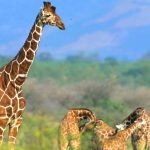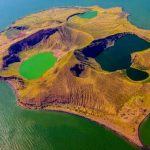This misty mountainous park features a dense forest and three crater lakes that are home to a range of reptiles, birdlife and mammals. Far from Nairobi, this forested area in the middle of a desert wilderness offers the only permanent source of water for the region. It is a refuge for huge tusked elephants and was home to Ahmed – a famous elephant that died at an estimated age of 63 years. He was under constant surveillance and when he died, his tusks were found to weigh over 300 kg. The National Museum of Nairobi hosts a model of Ahmed.
There are extinct volcanic craters known as gofs in the park with the biggest gof being Gof Bongole having a dizzying 10-kilometer round rim. The natural amphitheater of Gof Sokorte Guda has a 150 meters high caldera that shelters the fresh waters of Lake Paradise. Most of these craters are home to a diverse number of bird species.
A must-see in the area is the Marsabit Cultural Museum & Information Center. This is an education center offering information about the culture of the locals and the park itself. The museum preserves pieces of the rich culture and traditions of the Northern Kenya people with their tools or trade and traditional regalia. The museum also hosts various galleries of wildlife images and images of the local people captured and donated by individuals and organizations for the conservation while showcasing the beautiful blend of culture, wildlife and scenic landscapes.
Marsabit County is home to over ten different communities, each with a unique and pristine culture. These include; the larger pastoralist communities such as Borana, Gabbra, Rendille, Turkana, Somali, Samburu and the lesser known agro-pastoralists, skilled black smiths, hunters and gatherers such as, but not limited to the Burji, Saakuye, Konso, Waata, Garri, Sidama and Dasanach.
A visit to the park is not complete without a short trip to the singing wells. The wells feature a shared animal watering point for both domestic and wild animals. Herdsmen bring their animals to the well where they go down to fetch water filling the water troughs, and as the animals quench, the men break into songs and choruses that infiltrate into the air; thus ‘singing wells’.
Other activities to take part in while in the park include camel rides, hikes in the dense forest with a closed high canopy wreathed in mist, and bird watching, bush trekking, camping, and visits to Lake Paradise and Elephant pool.




